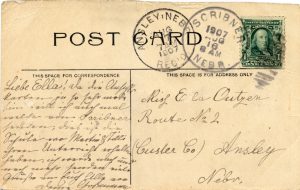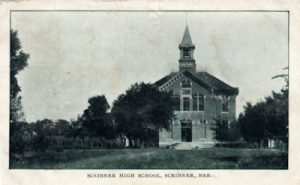Before I became a librarian, I worked as a researcher for a consulting firm. Most of my work focused on clients who were involved in environmentally-based litigation. While I mainly read typed or printed government records, occasionally a client asked me to look at older documents – shipping manifests, diaries and correspondence – stuff that was written in longhand! As you can imagine, I became proficient at reading nineteenth-century handwriting. Recently, I had a chance to put those skills to the test when a postcard written in German crossed my desk.

For the record, I cannot read or speak German. Before I asked a retired professor from Nebraska Wesleyan to translate, I attempted to do so using Google Translate. I realized pretty quickly the handwriting was not the nineteenth-century script I had dealt with previously. For starters, it may incorporate both German and English cursive.
The script appears to an older form of German-language handwriting known as Kurrent. Kurrent is based on late medieval cursive and German cursive. It was used heavily in Middle to High German-speaking regions during the nineteenth and early-twentieth centuries. Like any written script, Kurrent characters vary in shape and form, making it difficult to interpret.


This particular letter was written to a young woman, named Ella, by her grandmother. In the letter, Ella’s “Granny” mentions two people known to Ella, who had taught at Scribner High School. Although brief, Granny shares some family history, as well as let Ella know that she’s not far from her thoughts.
This letter also tells us that Ella reads, and most likely speaks German. Based on the fact that Kurrent was used in specific places, we have an idea of where Granny lived before moving to Nebraska. Additionally, Scribner wasn’t settled until the 1870s, when the railroad arrived. The high school featured in this image, wasn’t built until 1885. Granny most likely was a relatively recent arrival in eastern Nebraska.
Brief notes like this one can share a lot of information. They drop hints about the writer’s and the reader’s backgrounds and relationships. Postcards offer us a glimpse into the private worlds of people like Granny and Ella.
Visit
Nebraska Memories to search for or browse through many more historical images digitized from photographs, negatives, postcards, maps, lantern slides, books and other materials.
Nebraska Memories is a cooperative project to digitize Nebraska-related historical and cultural heritage materials and make them available to researchers of all ages via the Internet. Nebraska Memories is brought to you by the Nebraska Library Commission. If your institution is interested in participating in Nebraska Memories, see
http://nlc.nebraska.gov/nebraskamemories/participation.aspx.For more information, contact
Devra Dragos, Technology & Access Services Director.
 For the record, I cannot read or speak German. Before I asked a retired professor from Nebraska Wesleyan to translate, I attempted to do so using Google Translate. I realized pretty quickly the handwriting was not the nineteenth-century script I had dealt with previously. For starters, it may incorporate both German and English cursive.
The script appears to an older form of German-language handwriting known as Kurrent. Kurrent is based on late medieval cursive and German cursive. It was used heavily in Middle to High German-speaking regions during the nineteenth and early-twentieth centuries. Like any written script, Kurrent characters vary in shape and form, making it difficult to interpret.
For the record, I cannot read or speak German. Before I asked a retired professor from Nebraska Wesleyan to translate, I attempted to do so using Google Translate. I realized pretty quickly the handwriting was not the nineteenth-century script I had dealt with previously. For starters, it may incorporate both German and English cursive.
The script appears to an older form of German-language handwriting known as Kurrent. Kurrent is based on late medieval cursive and German cursive. It was used heavily in Middle to High German-speaking regions during the nineteenth and early-twentieth centuries. Like any written script, Kurrent characters vary in shape and form, making it difficult to interpret.

 This particular letter was written to a young woman, named Ella, by her grandmother. In the letter, Ella’s “Granny” mentions two people known to Ella, who had taught at Scribner High School. Although brief, Granny shares some family history, as well as let Ella know that she’s not far from her thoughts.
This letter also tells us that Ella reads, and most likely speaks German. Based on the fact that Kurrent was used in specific places, we have an idea of where Granny lived before moving to Nebraska. Additionally, Scribner wasn’t settled until the 1870s, when the railroad arrived. The high school featured in this image, wasn’t built until 1885. Granny most likely was a relatively recent arrival in eastern Nebraska.
Brief notes like this one can share a lot of information. They drop hints about the writer’s and the reader’s backgrounds and relationships. Postcards offer us a glimpse into the private worlds of people like Granny and Ella.
Visit Nebraska Memories to search for or browse through many more historical images digitized from photographs, negatives, postcards, maps, lantern slides, books and other materials.
Nebraska Memories is a cooperative project to digitize Nebraska-related historical and cultural heritage materials and make them available to researchers of all ages via the Internet. Nebraska Memories is brought to you by the Nebraska Library Commission. If your institution is interested in participating in Nebraska Memories, see http://nlc.nebraska.gov/nebraskamemories/participation.aspx.For more information, contact Devra Dragos, Technology & Access Services Director.
This particular letter was written to a young woman, named Ella, by her grandmother. In the letter, Ella’s “Granny” mentions two people known to Ella, who had taught at Scribner High School. Although brief, Granny shares some family history, as well as let Ella know that she’s not far from her thoughts.
This letter also tells us that Ella reads, and most likely speaks German. Based on the fact that Kurrent was used in specific places, we have an idea of where Granny lived before moving to Nebraska. Additionally, Scribner wasn’t settled until the 1870s, when the railroad arrived. The high school featured in this image, wasn’t built until 1885. Granny most likely was a relatively recent arrival in eastern Nebraska.
Brief notes like this one can share a lot of information. They drop hints about the writer’s and the reader’s backgrounds and relationships. Postcards offer us a glimpse into the private worlds of people like Granny and Ella.
Visit Nebraska Memories to search for or browse through many more historical images digitized from photographs, negatives, postcards, maps, lantern slides, books and other materials.
Nebraska Memories is a cooperative project to digitize Nebraska-related historical and cultural heritage materials and make them available to researchers of all ages via the Internet. Nebraska Memories is brought to you by the Nebraska Library Commission. If your institution is interested in participating in Nebraska Memories, see http://nlc.nebraska.gov/nebraskamemories/participation.aspx.For more information, contact Devra Dragos, Technology & Access Services Director. 

It is always so intriguing when you look at all the facts that play in the background of a story
THAT’S MY HOMETOWN!!! This is so cool!!